How many of you have always wanted to try to make your very own Creamy Homemade Ricotta Cheese? Well, today is the day! Are you excited? I sure am! I can’t wait to share this recipe with you!
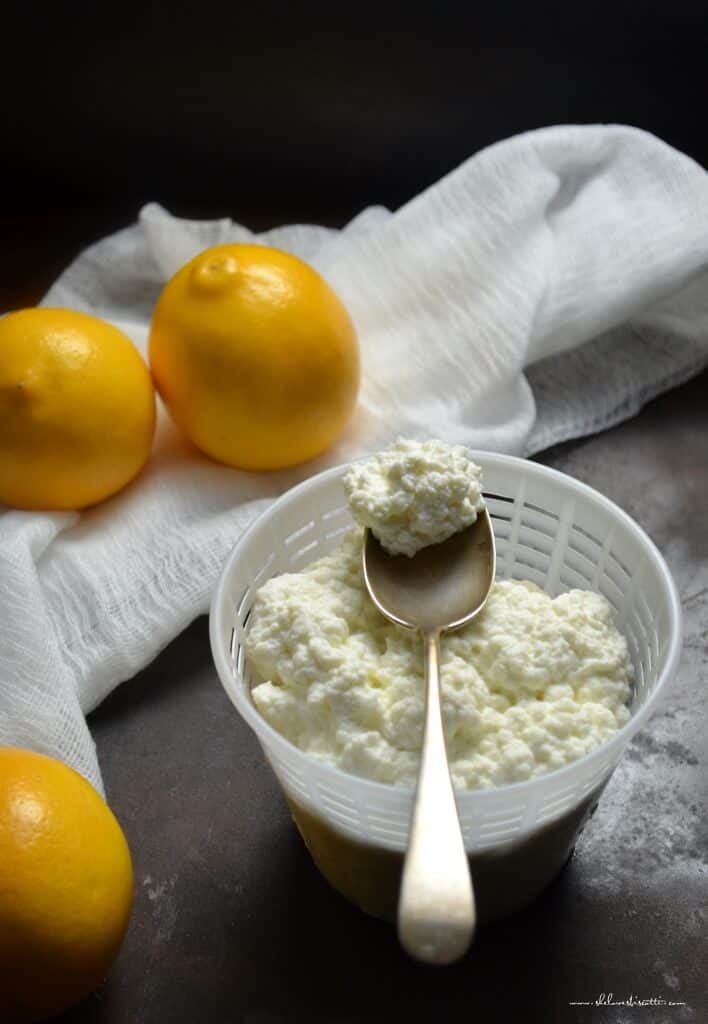
Who doesn’t like ricotta?
Its creamy texture lends itself perfectly to sweet foods like cannoli, cheesecake or this Rice Ricotta Easter Pie.
The taste and texture are equally appreciated in savory dishes, whether making Ricotta Cavatelli, used in Italian Stuffed Shells, or in a Tomato Ricotta Sauce.
It is also great when making Italian appetizers. One of my favorite “quick” appetizer recipes to make with fresh ricotta is these Ricotta Stuffed Medjool Dates.
In just under one hour, and with only 3 ingredients, you can be spreading some creamy ricotta on a toasted baguette with a drizzle of honey. It’s easy, economical and tastes great!
Life doesn’t get any better than this, my friends!
So…are you ready to begin?
What do I need to make Homemade Ricotta Cheese?
- Whole milk. Yes, full fat 3.25% milk.
- Salt. Adjust to your own personal taste.
- Lemon Juice. The acidity of the lemons will create those wonderful curds.
As far as accessories are concerned, you need a heavy bottom saucepan with a lid, a wooden spoon, a slotted ladle, a bowl, and a strainer.
You also need cheesecloth and a ricotta basket. The objective is not to lose any of the curds when you drain your freshly made ricotta. I reuse the plastic containers from the times that I purchase store-bought ricotta.
How to Make Ricotta Cheese
Begin by lining a large colander with a large piece of lightly dampened cheesecloth that has been folded over itself at least 3-4 times. Place the colander over a bowl. Make sure to use non-reactive materials. Alternatively, you can use a recycled ricotta basket. Set it aside while we begin to make the ricotta cheese from scratch.
You are now ready to combine two of the ingredients (milk and salt) in a large heavy-based saucepan.
Please note you CANNOT make ricotta with ultra-pasteurized milk.
Over medium heat, heat the milk to 185°F (85°C), making sure to give the mixture an occasional stir with a wooden spoon.
If you do not have a thermometer, heat the milk until it reaches a stage where there is a lot of steam, where little bubbles are forming close to the edge of the pot, and a slight film appears over the milk. It takes about 20 minutes to get to this stage at medium heat.
Making ricotta requires a source of acidity in order for the curds to form. I usually use lemon juice or white vinegar.
The results with lemon juice can vary since it depends on the acidity of the lemon. Don’t hesitate to add an additional tablespoon or two of lemon juice if your milk does not curdle immediately.
Do not use Meyer lemons as these are sweeter and do not have the same acidity as regular lemons.
Lemon juice is definitely my preference when making sweet recipes using ricotta cheese. Here are some examples: Easy Lemon Ricotta Pancakes, Italian Sweet Ricotta Easter Pie, or even this Rice Ricotta Easter Pie. Can you tell I just love ricotta!
I use white vinegar to make ricotta for savory dishes like pizza, lasagna, pasta, or these Spinach Calzones.
Reduce the heat to low and add your source of acid (I used lemon juice). You will notice that the mixture will immediately begin to curdle…continue to gently stir the mixture about for 2 minutes.
Isn’t it amazing that in just a few minutes, you will begin to notice the formation of curds?
You are well on your way!
Carefully remove your soon-to-be creamy homemade fresh ricotta cheese from the heat. Let it stand, covered for about 20 minutes.
Carefully ladle your ricotta into the cheesecloth-lined colander or your basket. Your bowl will be filled with a liquid, which, as you know, is whey.
Since we are talking about whey, I would like to clarify that true ricotta is made from the leftover whey of cheese production. Hence the name “ricotta”, which literally means “recooked”.
At this point, you have a decision to make. The consistency of the final product will depend on the amount of time you leave the mixture to drain.
If using the ricotta cheese to make a cheesecake or stuffed pasta, you need a firmer consistency – therefore allow to drain for at least 20 minutes. If you are using it as a spread (for example on a baguette), 3-5 minutes is more than enough time to obtain that creamy consistency.
As a personal preference, you can replace 1-2 cups of full-fat milk with cream. This creates even creamier ricotta.
What will you make with this homemade ricotta recipe?
Tips
- Replace the lemon juice with an equal amount of white vinegar.
- Reduce the draining time for a creamier consistency.
- Homemade ricotta cannot be made with ultra-pasteurized milk…so, check your labels.
- Use fresh ricotta immediately or cover and refrigerate for up to 3 days.
Can I use Meyer lemons to make homemade ricotta?
No, since this variety of lemons does not have the same level of acidity as regular lemons.
What is whey?
Whey is the liquid that is formed following the addition of the lemon juice and after straining the curds.
What can I make with whey?
The leftover whey is great to use when making bread, pizza, pasta or even in soups.
Can you freeze ricotta cheese?
Ricotta has the potential to spoil quickly, so you do need to use it within days of making your own or opening a store-bought container.
Although you can freeze your leftover ricotta and use it at a later date, the texture will change. More specifically, it will be crumbly when you thaw it.
It no longer tastes quite like fresh ricotta anymore. That being said, frozen ricotta can be used in recipes where other ingredients are mixed with it in cooked or baked dishes.
Tips on freezing ricotta
You need to freeze ricotta in an airtight container. You can just use the original packaging that it came in; be sure the container is tightly sealed. The more air that’s left in the container, the more ice crystals form, and this will give your cheese a gritty texture.
You can freeze ricotta for up to 3 months.
Before you use frozen ricotta in a recipe, thaw it overnight in the refrigerator and then mix well before using.
Ricotta cheese recipes we love
Recipe origins
During my youth, most Italian families made their own wine, their own sausages, cheese, prosciutto, tomato sauce, pickled vegetables, jams, jellies, pasta, bread…I could go on, but you get my point.
Imagine my surprise when I realized not everyone had homemade soppressata hanging in their cold room!
I realize now what a privilege it was to have been exposed to so much passion when it came to food. When I think back to my grandparents and my parents (and to a whole generation of immigrants), I am always impressed by how food helped preserve their identity.
The philosophy is easy -enjoy and share food with family and friends.
I hope you enjoy this ricotta in your favorite meals with your loved ones.
THANKS SO MUCH for following and being part of the She Loves Biscotti community where you will find Simple & Tasty Family-Friendly Recipes with an Italian Twist.
If you haven’t already joined, here is the link where you can sign up for my weekly e-mail newsletter. This way, you won’t miss any of my new recipes and it’s absolutely free!
Ciao for now,
Maria
★★★★★ If you have made this Homemade Ricotta Cheese recipe, I would love to hear about it in the comments below and be sure to rate the recipe!
Recipe
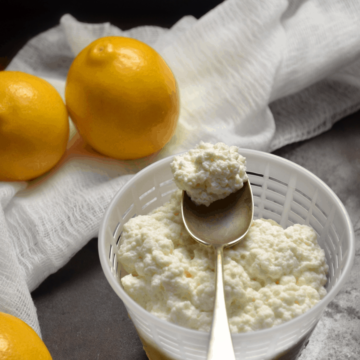
Homemade Ricotta Cheese
Ingredients
- 8 cups whole milk 2 liters
- ½ teaspoon salt
- 3 tablespoons lemon juice or white vinegar freshly squeezed
Instructions
- Line a colander with a large piece of lightly dampened cheesecloth that has been folded over itself at least 3-4 times. Place the colander over a bowl. Make sure to use non-reactive materials. (Alternatively, you can use a recycled ricotta basket placed on a bowl).
- In a large heavy based saucepan, over medium heat, heat the milk.
- Add the salt and stir occasionally with a wooden spoon. Make sure the milk does not scorch.
- If you have a thermometer, heat to 185 F. If you do not have a thermometer, you need to reach a stage where there is a lot of steam, little bubbles close to the edge of the pot and the formation of a slight film. It should take about 20 minutes to get to this stage.
- Lower the heat to low.
- Add the lemon juice (or vinegar).
- Slowly agitate the mixture for 2 minutes. You will notice the curds (the ricotta) separating from the whey (yellowish liquid).
- Remove from heat.
- Cover pot and let stand for about 20 minutes.
- Carefully “ladle” your ricotta into the cheesecloth lined colander or your basket. The consistency of the final product will depend on the amount of time you leave the ricotta to drain. For a creamy ricotta, let it sit for 3-5 minutes; for a dryer ricotta, it can sit up to 20 minutes.
- Use immediately. Cover and refrigerate any leftovers.
Video
Notes
- Replace the lemon juice with an equal amount of white vinegar.
- Reduce the draining time for a creamier consistency.
- Homemade ricotta cannot be made with ultra-pasteurized milk...so, read your labels.
- Use fresh ricotta immediately or cover and refrigerate for up to 3 days.
Inactive time: 20 minutes 1 serving = ½ cup Please keep in mind that the nutritional information provided below is just a rough estimate and variations can occur depending on the specific ingredients used.
Nutrition
This post was originally published on February 21, 2016 and republished on February 8, 2019 with updated content, photos and a video. Thanks for watching and sharing.


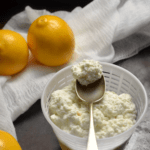
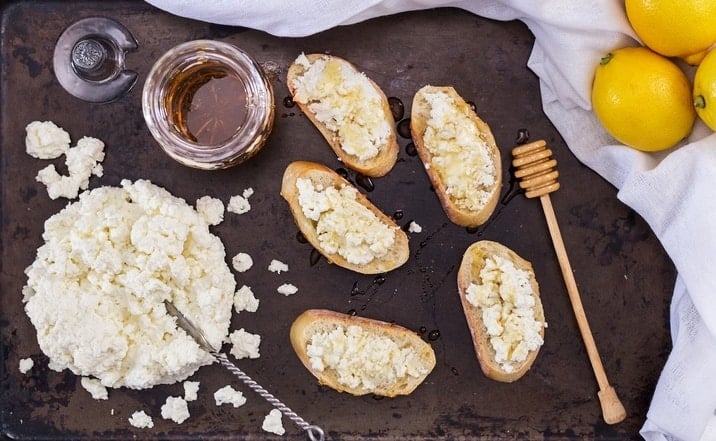
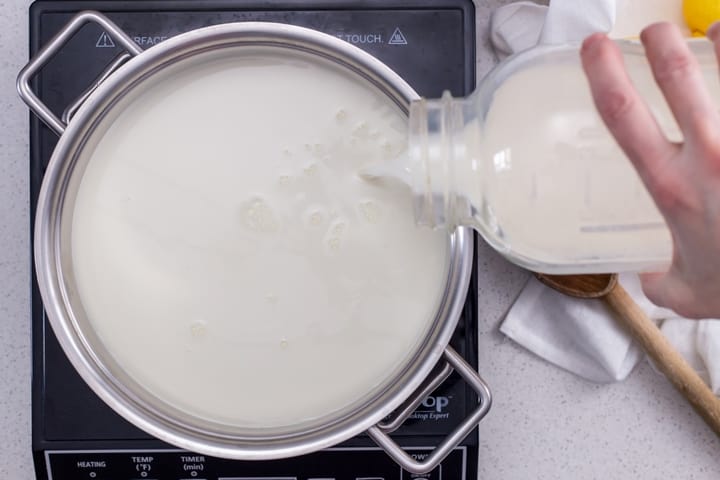
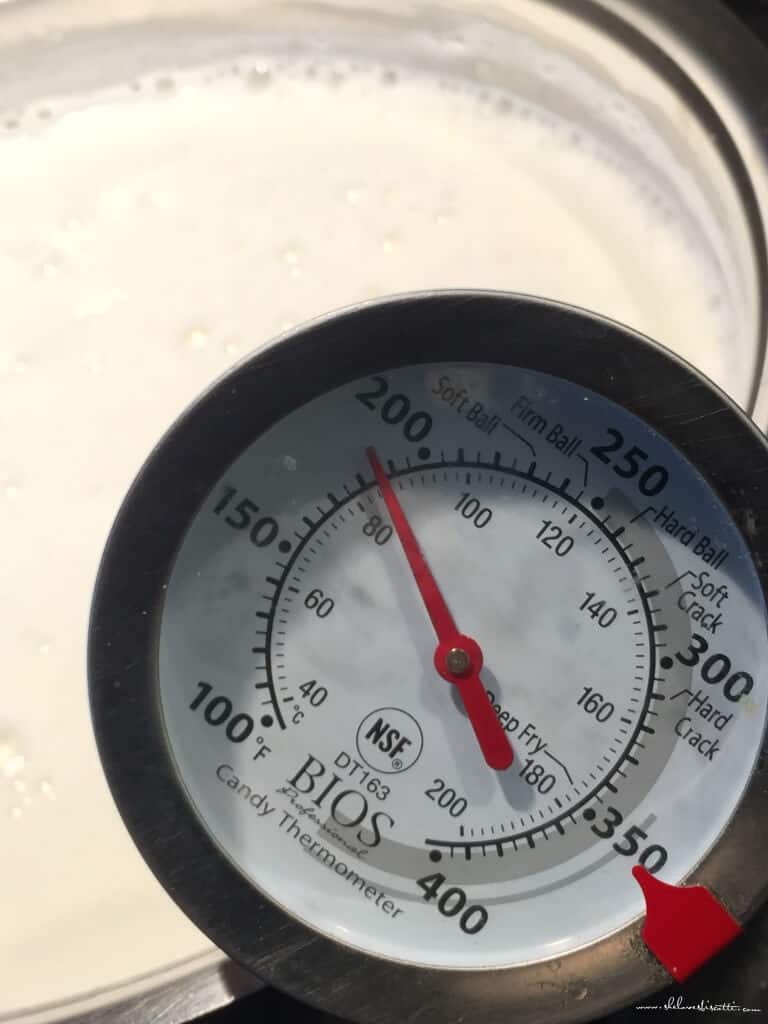
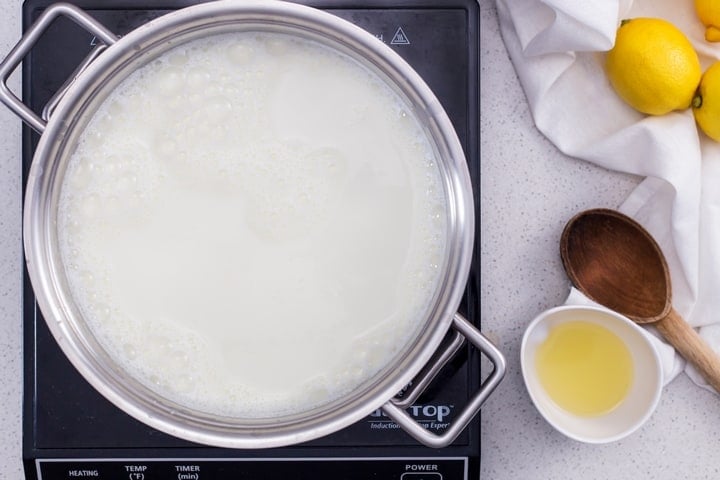
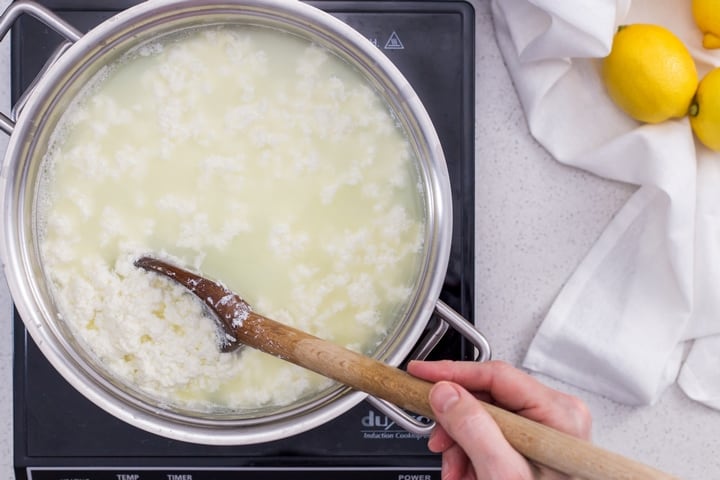
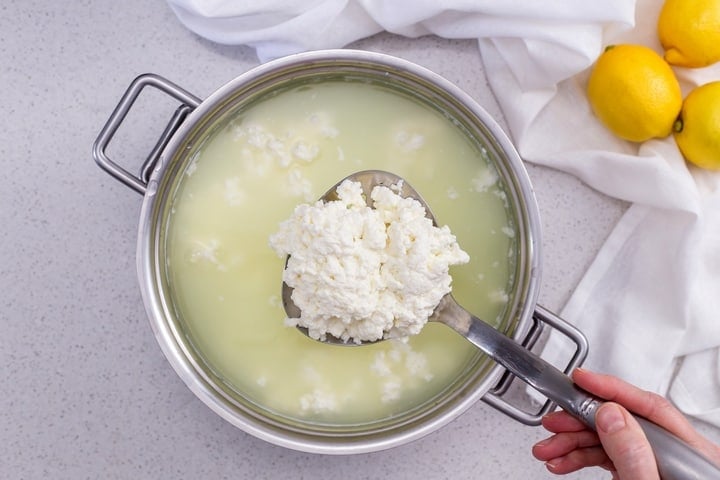
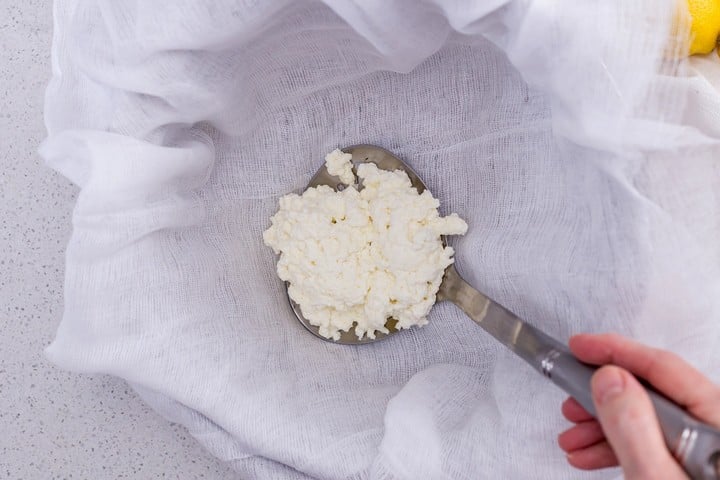
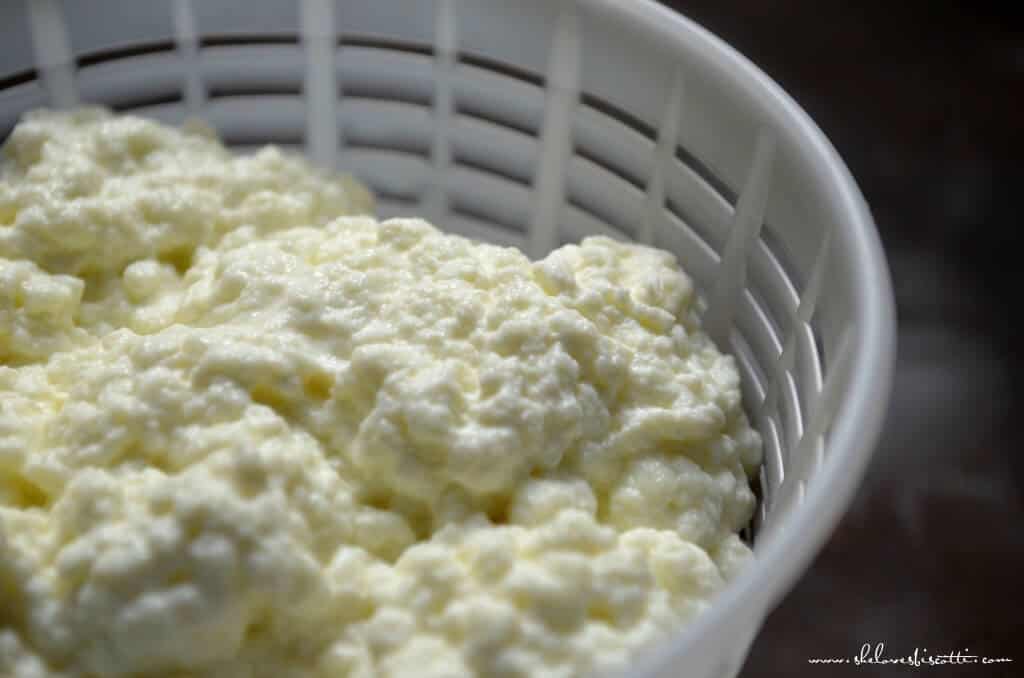
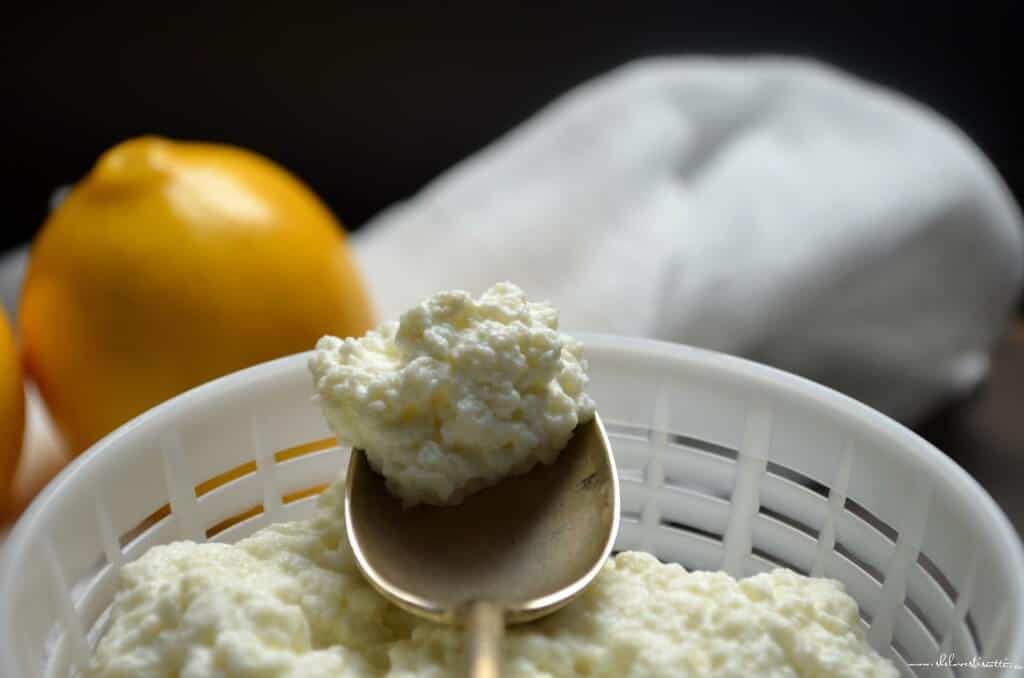
D
Love this recipe. Should have posted sooner. I’m not a person who does so the fact that you are reading this means it’s worth doing. Many thanks Maria for this recipe 🥰. I have used this so many times to my hearts content and with your other wonderful recipes
Maria
Thanks so much D ♥♥♥
Sandra
Thank you so much, am making Ricotta for the first time. It came out beautifully.
Maria
SO happy to hear this! Thanks for sharing Sandra!
Vayda Smith
I’m a college student and I needed something to do with my leftover milk before I left for spring break. I only made half of what the recipe said but it still worked wonders. This is a lifesaver!
Maria
Thanks so much for sharing Vayda! Enjoy your spring break!
Holly Farnell
If I double the recipe, should I double the vinegar too?
Maria
Yes, that is what I do for a double batch. Enjoy!
DKatherine
Outstanding! I took the author’s suggestion of replacing 2 cups of milk with cream. Everything else as per the base recipe. It’s the best, creamiest, and richest ricotta I’ve ever had. Better than the $9 I spent last week at the Italian market for ‘homemade’ ricotta. This cost me approx $3. I can’t get over how delicious this is. Thank you!
Maria
Thanks so much for sharing DK!
Susan Cacciato
Easy to make; I used whole milk
Produces a very creamy tasting ricotta.
I used the ricotta to make gnudi, very pleased with the end results.
Debra
Hi Maria, Sorry but I can’t find the quantities of the milk, salt and lemon and I really want to give this a go. Am I blind? Regards, Debra
Maria
Thanks for your interest Debra. The recipe card is located at the end of the article. There is a jump to recipe button at the top of the article which skips the step by step instructions. Enjoy!